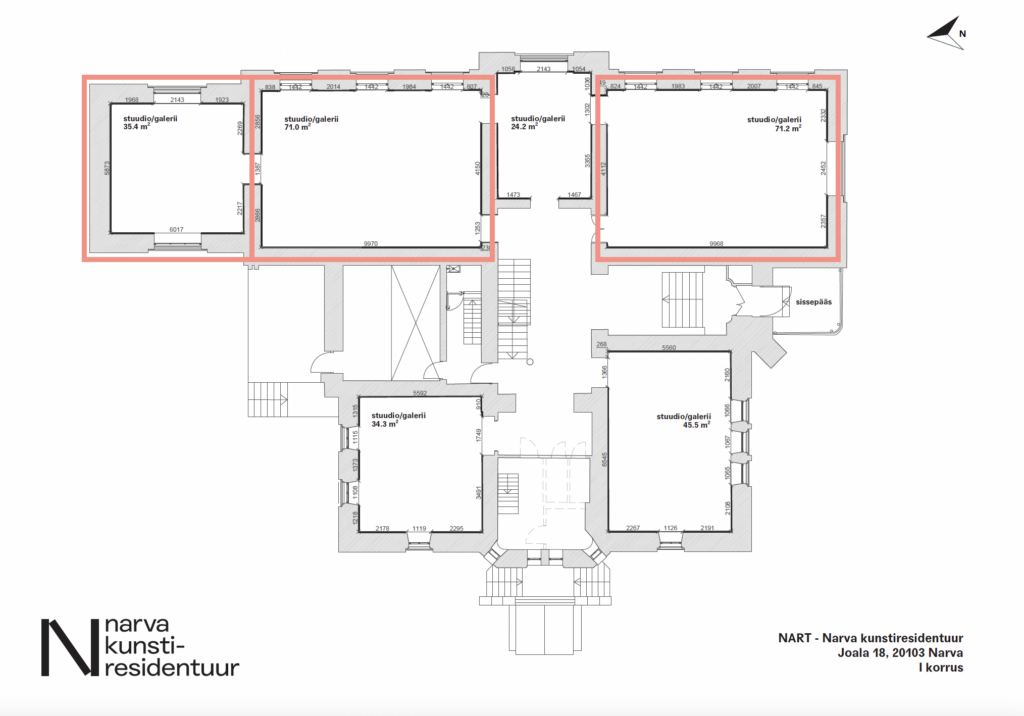Exhibition spaces
▪︎ We use three halls for our exhibition program – 30 sqm + 70 sqm + 70 sqm. Sometimes they are divided between two exhibitions, sometimes one exhibition takes all three halls.
▪︎ One of the two bigger 70 sqm halls should either have artworks only on the walls or the installations in the middle of the room should be easily movable. Sometimes we host large events (receptions for state structures, seminars, conferences etc) and need to make use of the exhibition halls as well
▪︎ The smaller exhibition hall (30sqm) is good for film or video works, because one of the windows is already darkened (and you can make the other one dark for the exhibition time).
▪︎ Sometimes exhibitions extend to some curious spaces around the house, even the cinema hall on the second floor. We are open to that happening! Sometimes the wall behind the main staircase, which is directly visible from the entrance, is used for a large sticker text with the title of the ongoing exhibition.
▪︎ Check out the 360 degrees photos of the interior HERE.

NB! The walls are brick walls and it’s heritage-protected. So it advised not to put screws in the wall. If it’s really necessary, you can make holes between bricks. or use existing holes. But the cement is kinda soft, so you need to put a wooden thingie in there for the screw to hold. It’s not possible to screw things into the ceiling.
NART can offer space and shares information, but the majority of tasks for preparing an exhibition are on the exhibiting artist, curator or exhibition team. Here is a list of things that NART can or is not able to offer in the process of preparing an exhibition.
What NART can offer?
1) NART provides exhibition space, opens four days a week and keeps an eye on the exhibition (the have interns are guides, but also employ local youth during weekends or summertime)
2) NART shares prepared information about the exhibition and related events on its channels, as well as share a prepared press release text
3) NART distributes posters around the city of Narva, if necessary
4) NART can help translate shorter social media texts into Estonian, English, into Russian
5) During installation and uninstallation, we can host the exhibition team in the dormitories
6) We have some tools for installation that can be used, but we may not have everything you need (we do not have a lazer leveller).
7) There are some leftover, secondhand materials available but one cannot rely on those (you need to bring screws, fishing cord, tape etc)
What NART cannot offer?
1) production of the exhibition
2) organizing the opening (including sponsorships, gifts, art bus, etc)
3) design/printing of banners and posters
4) organizing the public program, such as exhibition tours, educational programme etc
5) media relations (inviting critics, interviews, etc)
6) photographing the exhibition, photographing the opening (sometimes we have interns but wouldn’t reply on them, but we do have contracts of local photographers who could come to the opening)
7) installation of the exhibition (we do not have our own technician, in some cases if we have interns, and we can ask them to give a helping hand)
8) writing and translating exhibition texts into three languages
9 ) writing press releases and other announcements (for example, announcing the opening event)
10) project management and keeping the project budget,
11) exhibition design and publications.
Mediation at the exhibition
We suggest that all exhibition texts are in three languages because of our varied audiences. We also suggest that there are thorough written explanations about each work so that an interested visitor has the chance to learn more about it. It’s better if the explanations are next to the works, but a brochure is also good. When writing the texts, it’s better to think of readers who are not used to reading International Art English and appreciate clear and relatable messages (it is said that the texts in museums should be written with a 14 year old visitor in mind). There was one exhibition which had video interviews with the artists instead of texts and that was nice. Moreover, if there are any additional materials which would be useful for our gallery guides, please share them. Sometimes we record a short exhibition tour with the organisers and share it with the guides so that they have more information to share.
Communication time schedule
– The press release should be sent about 3-5 days before opening. The information on the website should be updated about 2-3 weeks before opening. For both, NART needs the texts, translations, visuals on time.
– It would be good to have a poster file, a square format for IG and a landscape format for FB. Please include NART logo on posters and banners (you can find the files HERE).
– Please send or bring the physical paper posters to NART 2 weeks before the opening (10-15 paper posters printed in A2 or A3 size, and 2 posters on weather-proof material in A1 size for the stands in front of the NART building).
– The dates for the opening and any other public programme events should be concretisized by the last week of the previous month (this is when we publish our monthly calendar).
– We also appreciate if texts and visuals for social media posts can be prepared at the beginning but also during the exhibition period to ensure that NART followers know about this great exhibition!